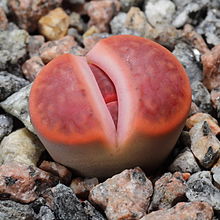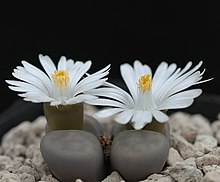| Lithops karasmontana | |
|---|---|

| |
| L. karasmontana, Cologne University Botanical Collection | |
| Scientific classification | |
| Kingdom: | Plantae |
| Clade: | Tracheophytes |
| Clade: | Angiosperms |
| Clade: | Eudicots |
| Order: | Caryophyllales |
| Family: | Aizoaceae |
| Genus: | Lithops |
| Species: | L. karasmontana |
| Binomial name | |
| Lithops karasmontana (Dinter & Schwantes) N.E.Br. | |
Lithops karasmontana, is a species of flowering plant in the ice plant family Aizoaceae, native to Namibia and South Africa (the name refers to the Great Karas Mountains of Namibia).
Description
It is a clump-forming succulent growing to 4 cm (2 in) high and spreading. The almost stemless leaves appear in pairs, and resemble two grey stones with brown mottling on the flat surfaces. White, narrow-rayed flowers 3–4 cm (1–2 in) in diameter, appear in autumn.

Lithops karasmontana resists attacks from herbivorous predators by mimicking the local stone formations, in this case quartzite. When not in flower it is extremely difficult to detect.
L. karasmontana is generally treated as having two subspecies bella and eberlanzii, as well as ssp. karasmontana, although one modern paper raises the two subspecies to species level on the basis of seed morphology. Ssp. bella is distinguished by its relatively uniform appearance with beige colouring and darker windows. It often forms very large clumps with up to 60 heads. Ssp. eberlanzii is much more variable in appearance, with colours and markings similar to ssp. karasmontana, but it is generally smaller, softer, and more convex.
Four varieties are also recognised: var. aiaisensis with creamy pinkish colouring, relative or complete lack of markings, and fairly smooth leaves; var. immaculata with almost unmarked beige leaves; var. lericheana with wide channels and greenish colouring; and var. tischeri with convex leaf tops and reddish colouring. Many older names are now sunk as synonyms in this highly variable species.
Cultivars

There are, as of 2023, 18 named cultivars of Lithops karasmontana:
- '50 Shades of Gray', with "pale plant bodies, honeycomb humps and dark condensed windows"
- 'Avocado Creme', a pale green form of ssp. eberlanzii
- 'Axel's Rose', red-bodied plants
- 'Cascade', a variegated ssp. bella
- 'Cookie', plants with orange tops and dark markings
- 'De Boer's Mick', with intense red markings
- 'Ironstone', ssp. bella with plain open windows
- 'Karasbijin', pale bodies with dark flecks
- 'Lateritia', with intense red to orange plain tops
- 'Lava Flow', a hybrid between var. tischeri and var. lericheana
- 'Lerichegreen', a green form of var. lericheana
- 'Mado-Shugengyoku', var. lericheana with a pinkish body and plain brown leaf tops
- 'Opalina', an unintentional publication as a cultivar of the plant originally published as L. opalina
- 'Orange Ice', var. aiaisensis with a strongly orange top
- 'Purper', a purple-bodied ssp. eberlanzii
- 'Rosary', plants with deformed leaves and an unusual growth habit
- 'Sunstone', a hybrid between ssp. bella and ssp. karasmontana
- 'Top Red', plants with a bright red network of channels
Cultivation
In temperate regions it must be grown in heat under glass, in conditions similar to those for cactuses. Like all Lithops, it requires extremely well-drained soil.
Like all Lithops it also grows in annual cycles, as the leaf-pairs flower, and then each produces a new leaf-pair that replaces the old one (which shrivels away). The principal rule of watering is that Lithops should be kept dry from when they finish flowering, until the old leaf-pairs are fully replaced. It has gained the Royal Horticultural Society's Award of Garden Merit.
References
- "Lithops karasmontana (Dinter & Schwantes) N.E.Br". Plants of the World Online. The Trustees of the Royal Botanic Gardens, Kew. n.d. Retrieved June 23, 2022.
- RHS A-Z encyclopedia of garden plants. United Kingdom: Dorling Kindersley. 2008. p. 1136. ISBN 978-1405332965.
- "Cactus Art - Lithops karasmontana 'Opalina'". Retrieved 26 June 2013.
- ^ Cole, D.T.; Cole, N.A. (2005). Lithops: Flowering Stones. Cactus & co. libri. Cactus & Company. ISBN 978-88-900511-7-3. Retrieved 2023-07-05.
- Earlé, Roy A.; Young, Andrew J. (2020). "The form, structure and size of Lithops N.E.Br. Seeds and the taxonomic implications". Bradleya. 2020 (38): 195. doi:10.25223/brad.n38.2020.a20. S2CID 220072147.
- Cole, D.T. (2012). "Lithops karasmontana subsp. karasmontana var. immaculata. A new variety". Cactus & Co.: 8–13.
- Hammer, S.A.; Barnhill, C. (2010). Lithops: Treasures of the Veld ; (observations on the Genus Lithops N. E. Br.). British Cactus and Succulent Society. ISBN 978-0-902099-92-0. Retrieved 2023-07-05.
- Keith Green. "The International Cultivar Registration Authority Register and Checklist for the genus Lithops N.E.Br". Scrapbooklithops. Retrieved 2023-07-09.
- "RHS Plant Selector - Lithops karasmontana". Retrieved 2 October 2020.
- "AGM Plants - Ornamental" (PDF). Royal Horticultural Society. July 2017. p. 61. Retrieved 25 March 2018.
| Taxon identifiers | |
|---|---|
| Lithops karasmontana |
|
| Mesembryanthemum karasmontanum | |